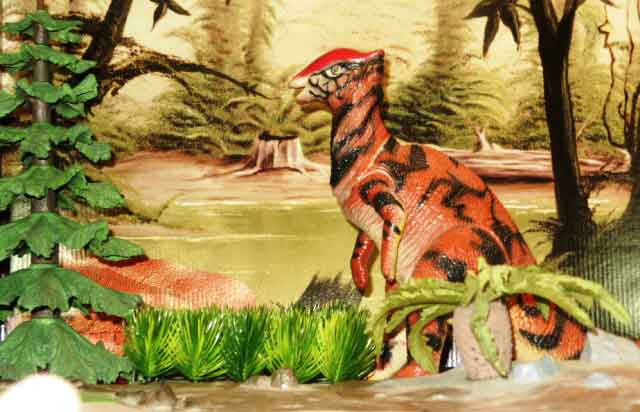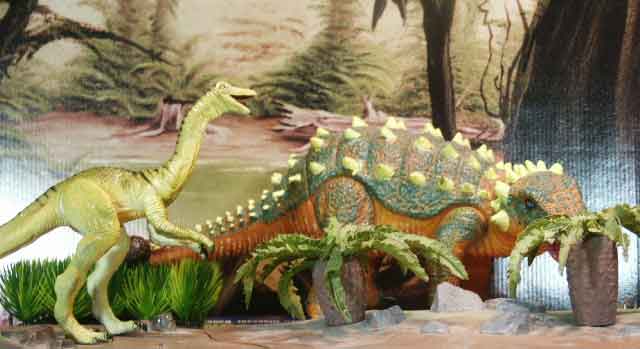

The Campanian was the golden age of the North American duckbilled dinosaurs. The duckbills can be divided into three broad families. The lambosaurines can be characterized by hollow head crests, high spines and narrow muzzles, and they may be descended from the ouranosaurs of the Early Cretaceous. The solid crested hadrosaurs had smaller solid head crests and broader beaks, while the crestless hadrosaurs were also broad beaked, suggesting a less discriminating diet.
The lambeosaurines are not well known for large bone beds like their crestless relatives. They seem like less credible candidates for living in large groups and making long seasonal migrations, although they may have come together in large groups during the breeding season. Parasaurolophus (near saulophus) is an uncommon fossil, but lasted into the following Maastrichtian. It is most famous for having the most prominent of crests of all the lamborsaurines; the most popular ideas current for its function being as amplifier for calls or an identifier for its prospective mates. The size of the crest is thought to be differentiated based on animal’s gender, and it looks to be relatively fragile so it may not have survived well as a fossil. If that is true, many of the indeterminate lamborsurine finds may actually represent Parasaurolophus.
 |
 |
|
| Small-scale series of figures are popular currently; center is the green Kaiyodo Choco Egg Parasaurolophus figure, the chubby purple figure is a KM, in back are three Jurassic Park figures, the orange figure from the play set, the yellow metal die cast, and hidden behind the Kaiyodo is a brown metal Match Box figure from the JP set. | Was the crest webbed or unwebbed? Parasaurolophus is often portrayed as having a web from the crest to back of its neck, as the blue and gold Battat figure and gold and green Wild Safari figures show. While they certainly look great, given the lack of fossil evidence, the most parsimonious interpretation is no web. The more conservative figures from Carnegie Safari and Schleich represent the technical view. The center left Carnegie Safari is the new figure with revised head, and the older, original head is to the far right. Between them is the hooting Schleich figure. |
It has been assumed that the crest was more distinctive on the adult males. Lambeosaurines look much alike without their distinctive crests, so many partial finds assigned to other members of the family could be Parasaurolophus fossils that were misidentified. One pattern found in living mammals is that the more solitary an animal is, the more elaborate the headgear used to display. Using that model, Parasaurolophus may have be a solitary animal - only coming together with others of it kind during breeding.
 |
||
| Furuta and Kabaya Parasaurolophus figures from Japan. | Starlux Corythosaurus and Trachodon with Funrise Corythosaurus. |
Corythosaurus (Helmet Lizard) was a thirty-foot long relative of Lambeosaurus, and is a very common fossil in the Campanian but disappears by the Maastrichtian. It lived in the better-watered lowlands, though after the Campanian lambosaurines in general seem to be in decline.
 |
 |
|
| Left are a discontinued Carnegie Safari Euoplocephalus and the Carnegie Safari Corythosaurus. Finally the Battat Euoplocephalus. The Jasman Diorama pachycephalosaur is representative of Stegocerus and other smaller relatives. | The Parasaurolophus is from Bullyland and the tyrannosaurid is from the AAA series of solid rubber dinosaurs. It has been customized with two small horns over the eyes to make it a Daspletosaurus. The brown Corythosaurus is a Schleich figure and behind it are two Waiphoon vinyl figures. In the right corner is the Retro Classic Hypsilophodon by Araki Kazunari. It appears to be based on the older Charles Knight painting, when Hypsilophodon was interpreted as a tree dweller. |
Saurolophus hadrosaurine had a prong on the back of its head that may have supported inflatable
nose pouches so the animal could bellow at rivals. It had a big, flattened tail and long slender limbs. Its feet
had 3 hoofed toes, and its hands had 4 fingers (2 hoofed). Saurolophus had a flat head, a long
straight lower jaw, a toothless beak, and batteries of cheek teeth.

Saurolophus from Skykids.
Maiasaura (the good mother dinosaur) was the first dinosaur given a female name ending. Jack Horner found giant nesting areas for this species of solid crested hadrosaur. It is estimated the site is from a colony of over 10,000 Maiasaura. The nests seem separated by about the body length of an adult Maiasaura, and it is suggested that the eggs were incubated by covering them with rotting vegetation, like some current day birds. There is evidence that the young remained in the nests and were cared for until they reached a certain size.
 |
 |
|
| Much like the original Carnegie Safari Maiasaura, the green Faro figure from Italy is sitting on the eggs. It seems unlikely that this was practical given the weight of Maiasaura. The Troodon are from the National Geographic MicroMachine series, and in the center is a Battat figure with a JP 3 nest and egg from the mold kit. Last is the current Carnegie Safari Maiasaura with nest. | The original Carnegie Safari Maiasauralacked the solid crest and is improbably sitting on the nest of eggs. It is still a good representative of the crestless hadrosaurs. The Maiasaura hatching is from the series 3 Dino Tales by Kaiyodo. The Battat Edmontonia is often imitated as a vinyl figure and seen in toy bins. |
Edmontonia was one of the last of the North American nodosaurs. Lacking the tail club of its cousin the Ankylosaurus but possessing impressive shoulder spikes and a narrow mouth, it may have been a more selective eater. This difference in feeding strategies could account for presence of two closely related animals; the armored dinosaurs Euoplocephalus and Edmontonia survive the Campanian age into the Maastrichtian. Euoplocephalus (Well-armored head) was an about twenty-foot long ankylosaur characterized by a tail club.

Skykids Struthiomimus and Euoplocephalus.
The large predators were Albertosaurus, Gorgosaurus and Daspletosaurus, smaller and younger relatives of the later and more famous Tyrannosaurus. Currently neither is thought to be ancestors of Tyrannosaurus, although Daspletosaurus is considered a close relative. The main visual difference besides size would have been the presence of small hornlets over the eyes. There have been some strong arguments put forth that place the larger tyrannosaurids as primarily scavengers. If that were true then the top predator role would have been filled by the small raptor Dromaeosaurus,which is not a common fossil. This would create the contradiction of the large scavenger being more common than the smaller top predator. It is possible Dromaeosaurus was more common than the fossil evidence indicates because of a preservation bias. Some small herbivores are also present, like the hypsilophidont Orodromeus.

AAA Dromesaurus.
Return to the Mesozoic Menu
More Campanian pages
Click on the Site A icon to the right for Dioramas organized by period or by manufacturer.